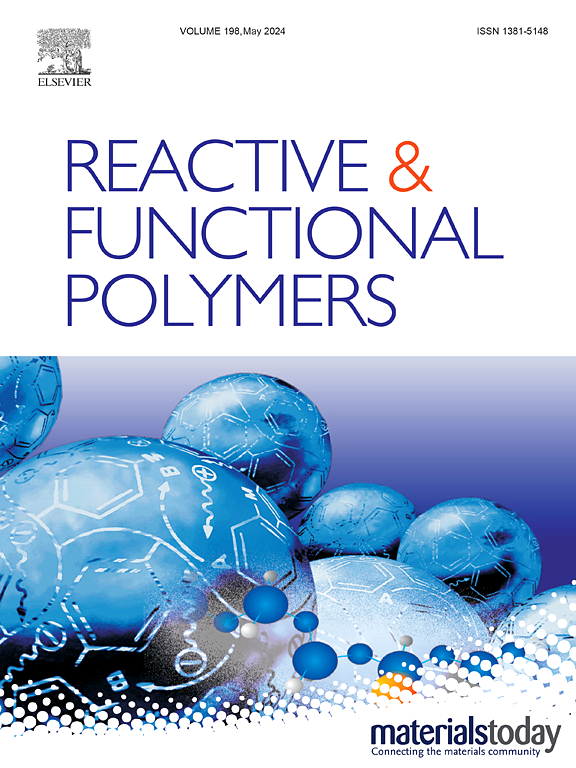Ultra-fast extraction of gold using spherical N-rich polymers
IF 5.1
3区 工程技术
Q1 CHEMISTRY, APPLIED
引用次数: 0
Abstract
In this study, we crafted nitrogen-laden microspheres known as PEI-GA, employing a straightforward, single-step synthesis at ambient temperature. We further validated their capacity as autonomous adsorbents, capable of achieving efficient, targeted, and swift extraction of gold ions (Au(III)) from aqueous media. The high nitrogen content of PEI, combined with its electrochemical adsorption ability, enables effective adsorption and reduction of Au(III) ions into gold nanoparticles, significantly enhancing the adsorption capacity and selectivity. PEI-GA exhibits an ultra-fast adsorption rate, achieving over 99 % Au(III) recovery in just 1 min at a concentration of 100 mg/L (m/V = 0.5 g/L). Moreover, even at higher concentrations (300 mg/L), the process only takes 5 min. The maximum adsorption capacity of PEI-GA reaches 2078 mg/g, following the Langmuir model and pseudo-second-order kinetics. PEI-GA also demonstrates excellent selectivity and recyclability, recovering over 95 % of gold ions from simulated e-waste solutions and maintaining 90 % recovery efficiency after five cycles. DFT calculations suggest that AuCl₄− tends to form multicentric coordination with N atoms in PEI-GA. This study highlights the cost-effectiveness of PEI-GA for Au(III) recovery, which can be further optimized through calcination or regeneration.

利用球形富n聚合物超快速提取金
在这项研究中,我们制作了被称为PEI-GA的含氮微球,采用了在室温下直接的单步合成方法。我们进一步验证了它们作为自主吸附剂的能力,能够从水介质中高效、有针对性、快速地提取金离子(Au(III))。PEI的高氮含量,结合其电化学吸附能力,使Au(III)离子有效吸附还原为金纳米颗粒,显著提高了吸附能力和选择性。PEI-GA表现出超快的吸附速率,在100 mg/L (m/V = 0.5 g/L)的浓度下,仅需1分钟即可实现99%以上的Au(III)回收率。此外,即使在较高的浓度(300 mg/L)下,该过程只需要5 min。PEI-GA的最大吸附量达到2078 mg/g,符合Langmuir模型和准二级动力学。PEI-GA还表现出优异的选择性和可回收性,从模拟电子垃圾溶液中回收95%以上的金离子,并在5次循环后保持90%的回收率。DFT计算表明,在PEI-GA中,AuCl₄−倾向于与N原子形成多中心配位。本研究强调了PEI-GA回收Au(III)的成本效益,可以通过煅烧或再生进一步优化。
本文章由计算机程序翻译,如有差异,请以英文原文为准。
求助全文
约1分钟内获得全文
求助全文
来源期刊

Reactive & Functional Polymers
工程技术-高分子科学
CiteScore
8.90
自引率
5.90%
发文量
259
审稿时长
27 days
期刊介绍:
Reactive & Functional Polymers provides a forum to disseminate original ideas, concepts and developments in the science and technology of polymers with functional groups, which impart specific chemical reactivity or physical, chemical, structural, biological, and pharmacological functionality. The scope covers organic polymers, acting for instance as reagents, catalysts, templates, ion-exchangers, selective sorbents, chelating or antimicrobial agents, drug carriers, sensors, membranes, and hydrogels. This also includes reactive cross-linkable prepolymers and high-performance thermosetting polymers, natural or degradable polymers, conducting polymers, and porous polymers.
Original research articles must contain thorough molecular and material characterization data on synthesis of the above polymers in combination with their applications. Applications include but are not limited to catalysis, water or effluent treatment, separations and recovery, electronics and information storage, energy conversion, encapsulation, or adhesion.
 求助内容:
求助内容: 应助结果提醒方式:
应助结果提醒方式:


